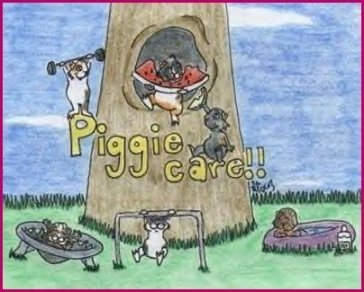Why hand feeding can be essential
Learning to hand feed your guinea pig, can play a vital role in helping your guinea pig recover from an illness. Sometimes it could even save your guinea pigs
life in an emergency. Remember if your guinea pig isn't eating, loss of appetite can be a secondary symptom, so please remember that hand feeding alone will not help your piggy recover from whatever is troubling them. Do not use hand feeding as a substitute for veterinary care. You need to see a vet as soon as possible to find out the cause of
why your guinea
pig isn't eating and drinking.
Bloat/Gastric Stasis
Caution: Some conditions must be immediately diagnosed and treated by a vet as continued hand feeding could make the problem worse by over filling the stomach. If your guinea pig looks bloated, their abdomen may be full of gas/air, fluid or both. They may have an intestinal blockage. They may also be in gastric stasis which means the digestive system is shutting down or has completly shut down. If your guinea pig isn't producing any kind of fecal matter and/or your guinea pigs abdomen looks bloated/swollen this is a very serious and painful condition which requires immediate veterinary care. For reference, please read the following links. The third link is about rabbit gastric stasis, but is an excellent link that will give you information about gastric stasis.
Peter Gurney: Bloat
Guinea Lynx Forum: Bloat
GastroIntestinal Stasis
There could be many reasons why your guinea pig stops eating or eating very little. Hand feeding will hopefully help to keep the digestive system going. Your guinea pig will also need
syringes of water to keep them hydrated until you can take your guinea pig to a vet. Please don't delay seeking veterinary care, I cannot stress this enough.
As you have already noticed, guinea pigs continuously eat all day and throughout the night. Guinea pigs need to keep eating high fibre food continuously,
otherwise their digestive system will close down. In as little as 8 to 12 hours of a guinea pig not eating and drinking, it may cause your guinea pig
to become very poorly or worse, you may loose your guinea pig.
This page is for adult guinea pigs, if you need information about hand feeding a baby guinea pig, please visit: Hand feeding a Baby Guinea Pig
Signs that your guinea may be poorly
Although not all guinea pig ailments mean you have to syringe feed your guinea pig, but if they are refusing food or eating very little, then hand feeding is essential. It helps to learn and watch out for warning signs that your guinea
pig isn't 100% healthy. Remember guinea pigs can try to hide an illness, in the wild they are a prey animal. A poorly guinea pig
doesn't want to be singled out by a predator because they are showing signs of weakness. But as a responsible owner, some ailments and changes can be noticed early. Looking for signs that your guinea pig is poorly, should be a part of your everyday routine. You soon get to know your
guinea pigs behaviour if you spend time with them. When feeding your guinea pig, please
don't just drop the food in the cage and walk away. Just spend a couple of
minutes watching them to make sure they are eating ok. There could be many reasons why your guinea pig refuses food or eats very little. Signs that you may need to hand feed are:
1) Refusing food and water, showing great difficulty while eating food or eating very slowly. Refusing hard vegetables like carrot that they would normally enjoy. Some of these symptoms could mean your guinea pig has a dental problem.
2) Diarrhoea: smelly poops, soft, misshapen or watery/loose poops in the cage, may also have a messy bottom.
3) Opposite to diarrhoea is when a guinea pig isn't producing any kind of poop/urine. Caution: If you haven't already read the link at the top of the page about bloat/gastric stasis, please do. Certain conditions like these need immediate veterinary care.
4) Hunched up in a corner, looking depressed, not responding when you call their name, hair puffed up, lethargic, no interest in what's going on around them.
5) Antibiotic intolerance , see index at the top of the page.
For more information, please visit my Health Check Page
Please remember Any of the above signs will need vetrinary care as soon as possible.
Reasons why you need to hand feed
If your guinea pig is refusing food and water and your not able to visit your vets
within 2 to 3 hours, its essential that you start hand feeding. Remember your piggy may have become poorly during the night and if they have not been eating, precious time has
already been taken.
Sometimes a guinea pig may refuse food after an operation. If your piggy is in pain after the operation, they may not want
to eat. A good idea is to ask your vet for a pain relieving medication.
Sometimes a vet will have already given a pain relief injection after the operation, but they may need further pain relief prescribed by your vet.
If your piggy has needed dental treatment because of an overgrown molar,
a mouth sore/ulcer may have appeared and it will be painful for your guinea pig to eat until it has healed.
Antibiotic Intolerance
For whatever reason, your vet may have prescribed
antibiotic for your guinea pig. Some guinea pigs develop an intolerance to it. They
may start eating less or refuse to eat completely. They may also develop diarrhoea. After my Squeekie's neutering
operation, he was
perscribed a
small course of antibiotic.
By day 2, he became withdrawn and refused to eat any food, even a fresh dandelion leaf or a piece of cucumber wouldn't
tempt him to eat. After speaking to my vet, it was decided that I split his daily
dose
of antibiotic into two. Giving him 0.2ml and the other 0.2ml a few hours later. It worked for Squeekie but sometimes
it might not and a possible change of antibiotic may be needed.
Safe antibiotics are Bactrim and
Baytril. Safe Medications Sometimes your vet will give you a probiotic to help your guinea pigs gut flora, as an antibiotic can effect
the balance to a small or greater degree.
What I need to syringe feed my guinea pig
Its always a good idea to be prepared before your guinea pig becomes poorly. Start
bringing together a first aid kit: Items that you will need for hand feeding include:
1-ml syringes and 2-ml syringes, also known as 1-cc or 2-cc syringes. Ask your vet for several needless syringes, both sizes, you may have to pay a small charge.
You may recognise them if you have ever been prescribed medicine for you piggy. The 1-ml syringe is suitable for giving medicine or
water. After experimenting, I now find the 2-ml syringe a very good
size for administrating a feed formula and isn't too intrusive for a guinea pigs mouth. You can make the mixture quite thick (toothpaste consistency) and it will travel through a 2-ml syringe. However, you will need to cut the
tip of the syringe off, so the food moves freely through the syringe and doesn't become blocked. Remember to make sure there are no sharp edges, so use a little sandpaper to smooth over the edges, rinse the syringe well after using sandpaper. See photo below.
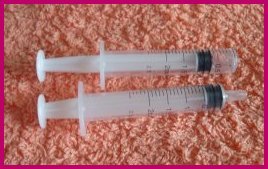
Critical Care/Recovery or pellets: Critical Care is a high fibre Timothy hay based formular especially made for syringe feeding. It can be more difficult to get hold of in the UK. However, I've recently discovered that Thistle Cavies Shop UK is now selling it. Some vets in the UK may also stock it. Usually my vet offers me Supreme Science Recovery which is the UK version of Critical Care. However I've found the Critical Care seems to be enjoyed by my piggies more than any other feed. If you don't have any Critical Care or Recovery sachets in the house, you can also use your piggies food pellets to make a mash.
My piggies have Oxbow's Cavy Cuisine pellets which are very high in fibre and I usually make a mash out of them if needed. Another good guinea pig pellet food is Burgess Supa Guinea Excel
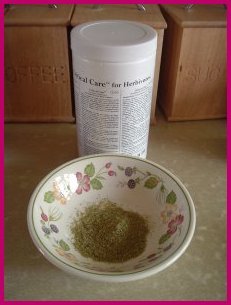 |
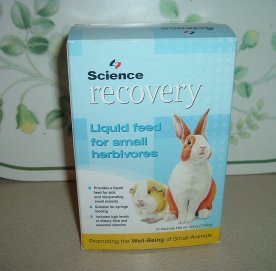 |
| Critical Care (add water) |
Recovery Liquid Feed (add water) |
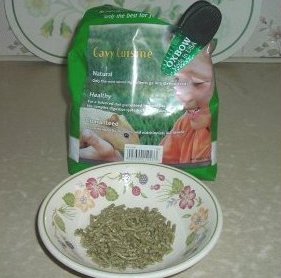 |
| Cavy Cuisine Pellets (add water) |
Probiotic: Its always wise to have a probiotic in your guinea pigs first aid kit. My vet always gives
me several sachets of Bio-Lapis if one of my guinea pigs is on a course of antibiotic. I usually administer some probiotic roughly an hour after taking the antibiotic. A probiotic may also help to boost your guinea pigs appetite. I always keep 2 or 3 sachets for emergencies.
You can also buy a probiotic
on-line in the UK Thistle Cavies Shop UK
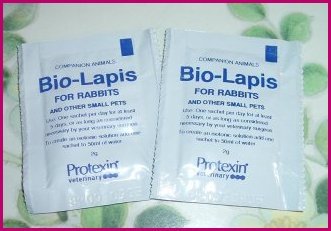
Poop soup: If you don't have any probiotic in the house, another
alternative is to use a freshly produced poop from a healthy guinea pig, mash it up and add a little water and syringe feed it to your poorly guinea pig. It may
sound unsavoury, but its another good way to help with
your piggies gut flora and help them to regain their appetite. You won't
need to wait very long to retrieve a poop from a healthy guinea pig. It is best if you use a fresh one.
While my Squeekie was recovering from a sore
mouth because he needed dental treatment, I was amazed that he was actually taking fresh poops as
they appeared from his cage mates bottoms!. Its the first time
I'd witnessed this behaviour. At first I wondered why he was constantly nudging the girls
bottoms. I soon realised what
he was doing as he was happily munching away, my girls didn't object too much. So
take it from Squeekie, a poop from a healthy guinea pig is very good for a poorly one.
Organic vegetable baby food: Its very handy to have a jar of vegetable baby food in
the house. Always check the 'sell by date'! I only use it to flavour the feed. Please don't just give your
piggy baby food, there's not enough
fibre in it. If your guinea pig has diarrhoea, leave the vegetable baby food out, until the poops are near to normal.
Vitamin c supplement: While your guinea pig is poorly, they will need added
vitamin c. If you are having to hand feed, they won't be eating their normal
intake of vitamin c vegetables or if your piggy has diarrhoea, you will need to stop all vegetables and fruit until the diarrhoea has
cleared. I use Oxbows vitamin c 50mg chewable tablets and I give half a tablet which is 25mg each day with a little water via a 1-ml syringe. If you are treating your guinea pig for a vitamin c deficiency, 50mg is normally recommended, but always ask your vet. If you live in the UK, you can buy Oxbows vitamin c
tablets on-line from Bunny Mail or you can buy them directly from the USA
Oxbow Hay Company USA
Please do not give your guinea pig a multivitamin, excessive amounts of certain vitamins may cause serious problems.
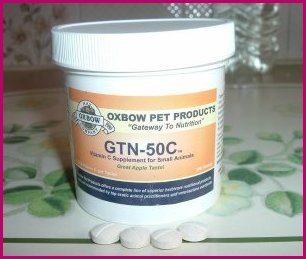
50mg Vitamin C Tablets
Cranberry juice:
Cranberry Juice is very handy if your guinea pig has a urinary tract infection. A
few syringes of cranberry juice with each feed will help to break down the acid in their urine. Only buy the
un-sweetened cranberry juice, most piggies will love it. It also has the much needed vitamin c, so that's an added bonus.
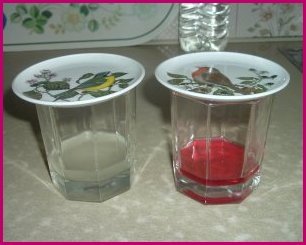
Probiotic and Cranberry Juice
Metatone tonic:
Metatone tonic, which is actually for humans when they are feeling run down, can be used to induce and regain a guinea pigs appetite. Important: Ask your vet before giving your guinea pig Metatone tonic. Dosage is 0.5ml daily for the
first week and 0.3ml daily for the second week. You can buy metatone tonic from a Chemist.
Preparation for hand feeding
Now that you have the basic items for hand feeding, you need to have everything prepared. If you are going to use say
a kitchen work top to feed your guinea pig on, you need to have everything at hand. Never leave a piggy unattended
on any high surface. They could fall off in seconds while your back is turned.
First of all, acquire two hand towels. One towel for sitting piggy on, for comfort and so they don't slip. A towel also helps
to keep the area you are using clean, as syringe feeding can be messy. If your inexperienced or have a very difficult
guinea pig to handle, who will do anything to avoid being fed, the other towel is handy for wrapping around piggy.
Just allow their head to peep out.
So far I've not needed to use this technique, but it must be handy to use for a more reluctant guinea pig.
If you are using a powder feed like Recovery or Critical Care, you just need to add a little warm water to make it into
a paste. Remember to use an intact 2-ml syringe to help you control the amount of water you are adding to the food. Check that the food goes through the syringe freely, but it shouldn't be too watery!. The food should look similar in consistancy to tooth paste. A drier mix will
also stimulate the digestive system and encourage your guinea pig to chew. If you are making
a pellet mash, you will need to
pre-soak the pellets, using a little warm water. Your guinea pig will appreciate the mash being a little warm rather
than stone cold. You could use a mortar and pestle to grind down
the pellets into a powder and then add a little water until you are happy with the consistency . Alternatively, you could grind the
pellets down with the back of a spoon. Only use a small amount of pellets, as its best to make up a fresh pellet mash for
every feed. To flavour, you could add a little finally chopped parsley or add a little organic vegetable baby food.
Have your syringes ready. You will need to use at least two. One for administrating water and one for the mash.
Remember to cut the tip off the syringe that you are using to feed your guinea pig.
Prepare your probiotic by adding one sachet to 30 mls of water. One sachet is enough for each day.
I use a glass and place a small plate over it, when not in use, also keep it out of direct sunlight. Even if you
haven't used all the probiotic within 24 hours, always throw the remaining out after 24 hours and make a fresh one.
A soft toilet paper roll is very handy to have near you, to help mop up any mess.
I use some on the towel, like a napkin, just where piggies head will be.
Its also useful for wiping piggies chin. Guinea Pigs are very clean animals and aren't happy having a messy mouth,
especially if the mess is heading down onto their chest.
Medication
If your guinea pig is taking medication prescribed by your vet, a good idea is to give your guinea pig the medication before you start hand feeding. Guinea pigs can store a little food in their
mouth for a short time after feeding. So by giving piggy the medication first, the mouth
will be clear of food debris. Many guinea
pigs hate the flavour of antibiotic, although my Clover actually likes it. After administrating the medicine, if they will eat it, give them a
little cucumber to help remove the taste of the medicine. As the old saying goes 'A spoonful of cucumber helps the medicine go down'! Always read the dosage on the label, never guess and give a liquid medication a little shake with the top on before administrating the medicine
to your guinea pig. However, check with your vet if it indeed needs shaking.
How to syringe feed
I use the kitchen work top as its an ideal height to have more control of your guinea pig. If your inexperienced,
you may want another person with you, either to help you hold
the guinea pig or be there for the unexpected. Remember guinea pigs are professionals at reversing backwards! Never
place your guinea pig on their back to feed them, the risk of aspiration ( fluid entering the lungs ) is much greater.
Place your palm over your guinea pigs head, using two fingers and your thumb to gently grip the guinea pigs mouth. Try to keep the head still while feeding piggy.
Do not lift their head too high, again it may increase the risk of aspiration.
At this point your guinea pig may struggle, remember that you are doing your guinea pig an enormous deed by hand feeding them.
You may feel your having to use force,
but force feeding can help to save a guinea pigs life.
Even if your guinea pig struggles or they may keep lifting
a front paw to try and remove your hand or syringe, please stay calm, do not shout at your guinea pig or use excessive force.
A guinea pig that has never been syringe fed may really dislike the experience and is just afraid.
My Clover
has been syringed fed on two different occasions.
Each feed became easier and most do get used to it.
Only recently when my Clover's appetite was improving, but not enough to withhold the syringe feeding completly,
she could smell the syringe even before it reached her lips and she started tugging at the syringe,
wondering
why the food wasn't coming out. At this point you could try placing the food on a teaspoon to see if piggy will help themselves.
Place the syringe into the side of the
guinea pigs mouth, behind the upper two front teeth. Warning: Do not squirt the food or any liquid into the back of the throat, you could make
your guinea choke ( guinea pigs cannot vomit ) and it could even go down the wrong way and enter into the lungs. You'll notice a gap after the front teeth, just further down,
are the
molar teeth. You may not be able to see them, but you may notice a little pressure on the syringe when your guinea pig starts chewing. Slowly release the food into the
side of the mouth as though you were aiming for the other side. Remember your guinea pig needs time chew and swallow, so release the food or liquid very slowly. Its much safer to go at a slow pace rather than risk aspiration. Use one syringe of food, followed by two syringes of plain water or vitamin c water. Remember to give your
guinea pig a cuddle afterwards to reassure them and help your piggy to feel secure.
How much and how often
A fully grown guinea pig will need roughly 6-8 syringes of food from a 2-ml syringe for each feed and around 15 syringes of water from a 1-ml every 3 to 4 hours. You can half the amount and
feed every two hours if you prefer. Baby guinea pigs especially would need to be fed a little and often. As long as your
guinea pig is getting a regular supply of food and water
inside them. This also includes night feeds. A guinea pig that is not
eating cannot be left through the night without having had any food and water. You need to keep
the digestive system going and keep piggy hydrated with water.
Encouraging your guinea pig to eat by themselves
Even though you are needing to hand feed your guinea pig, always have hay, pellets and water available to them at all
times, incase
piggy decides to start eating and drinking by themselves. Unless they have diarrhoea, offer
small pieces of their favourite vegetables frequently. If they've had dental treatment, cut the vegetables up into small pieces
and offer them to piggy regularly. You can leave a few small pieces of vegetables in the cage, but replace them after
a couple of hours so they are
always fresh. If offering grass, remove any uneaten grass after around 30 minutes as grass wilts very quickly.
Only discontinue the syringe feeding or decrease the amount when you know your guinea pig is happily
tucking into their food. Keep the syringe feeding going if piggy is just picking at the food.
Its a good sign if they do show
some interest, but you still need to supplement their food until they are eating an ample amount of food and water.
Weighing your guinea pig
Its a good idea to weigh your guinea pig every day while they are poorly. Your guinea pigs weight should stay stable or be increased. If you feel piggy is loosing weight, you need to have a word with your vet as soon as possible. I personally think a fully grown guinea pig should not weigh less than 2lb but remember some breeds are much smaller than others so this has to be taken into account. When Squeekie had dental
treatment to correct an overgrown molar, his suffering wasn't over,
he had a mouth sore/ulcer that needed time to heal. He found it difficult to feed by himself. During his time at the vets, which included dental treatment
on a back molar, his weight plummeted very quickly. When he came home, I managed to keep his weight stable at just over 2lb, but he looked very thin. So please do keep a close eye on your guinea pigs weight.
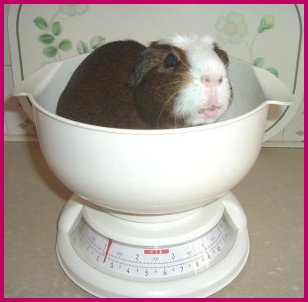
Squeekie being weighed
Hygiene
Always wash your hands thoroughly before and after handling a poorly guinea pig. Keep their cage as clean and as comfortable as possible. You may have to change the newspaper
and towels several times a day, but a clean hospital cage helps your guinea pig to feel comfortable and clean. Its imperative if a guinea pig has needed stitches to keep the
cage very clean so this will lesson the risk of infection.
After each feeding session, rinse out all syringes and extend the syringes, allowing them to dry. Keep the syringes in a clean plastic container, don't leave them out as they could attract flies. Keep work surfaces clean, very much like you would
if you was preparing food in the kitchen.
Checking your guinea pigs output
Being a guinea pig nurse involves checking to see if your guinea pig is producing wee and poops. Please keep the cage clean as much as possible. Keep your guinea pig on light coloured towels, so your able to see what
they are producing. Light coloured towels are also useful for when your guinea pig has needed stitches after an operation. They will enable you to
look out for signs of blood and infection. You can also use Vetbed animal bedding. Here is my link on how you can prepare a hospital cage.Hospital Cage
Separation from cage mates?
When a guinea pig is poorly, you may need to separate the poorly guinea pig from their cages mates, especially if its an infectious illness. Please make sure you have the all
clear from your vet, before putting your
poorly guinea pig near or back with their cage mates, if they have had an infectious illness. If it is an infectious illness, keep a very close eye on all your
guinea pigs as they may have already caught the infection. If they are
recovering from an operation, you can keep your poorly guinea pigs cage next to their cage mates, so they can still see and talk to them. They
will appreciate the familiar surroundings and company. They will also have the
option of having the opportunity to rest, without a possible disturbance from a cage mate wanting to pinch their sleeping area, most importantly it avoids a cage mate wanting to mess with any stitches.
Keeping your ill guinea pig separated will give you the added advantage of being able to monitor their urine, poops and to look for signs of
blood or infection. Some guinea pigs develop a very close bond with their cage mate so you will need to talk to your vet whether the separation would mean the poorly guinea pig would be more stressed away from their cage mate.
|
Copyright © Jackie's Guinea Piggies
|
|
